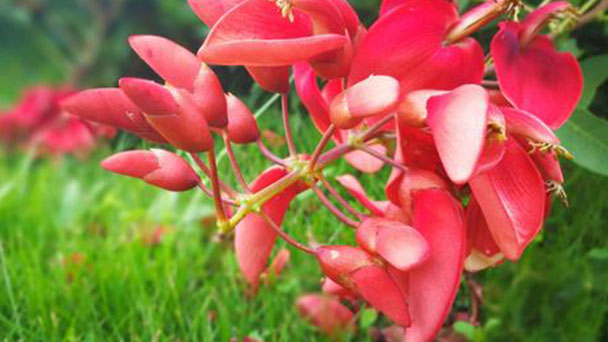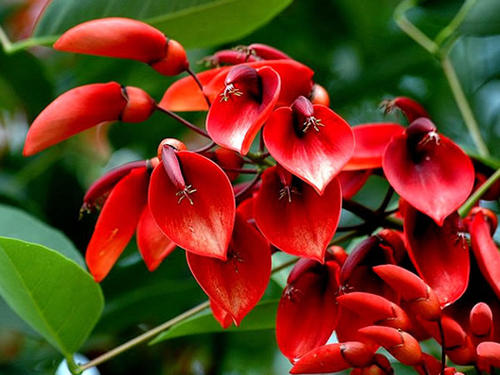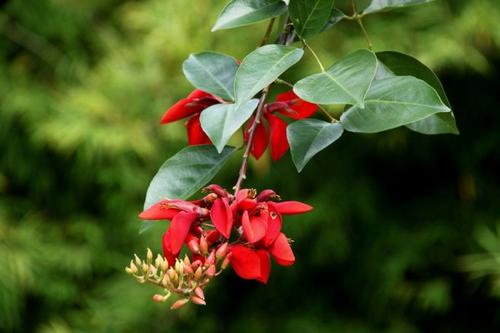Coral tree (Erythrina crista-galli) profile
Written by Maggie
Mar 11 2021

Coral tree (Erythrina crista-galli), also called cockspur coral tree, is a deciduous shrub or small tree. Coral trees grow in China. When it blooms, Coral tree is red and has a long flowering period, so it is suitable for viewing in courtyards and for greening in the middle of roads. Its trunk thickness can be up to 50 centimeters, the tree is about 5-8 meters high, and can even grow to about 10 meters.
Coral tree picture

Morphological characteristics of coral trees
Coral tree is a deciduous shrub or small tree with slightly prickly stems and petioles. Plant height is2 to 4 meters, deciduous small trees. Leaves are long ovate, pinnate compound, odd, 1-gyrate, leaflets 1 to 2 pairs of ovate, pinnate lateral veins; Three compound leaves, leathery. Flossing ca. spring, axillary, racemes, corolla orange red, flag obovate specially spatulate, as long as keel, wide and erect, winged incomplete. More than a bunch of petals, stamens, yellow anthers, bare.
Compound leaves of Coral tree are pinnate with 3-leaflet; Leaflets are ovate or lanceolate oblong, 7-10 cm long, 3-4.5 cm wide, apex obtuse, base suborbicular. Flowers and leaves are together, racemes terminal, each node with 1-3 flowers; Flowers are dark red, 3-5 cm long, slightly pendulous or at right angles to inflorescence axis; Calyx of Coral tree is campanulate, apex dislobed; Stamen is disomy; Ovaries are stipitate, tomentose. Pod ca. is 15 cm long, brown, constricted interseeded; Seeds are large, bright brown, a seed 3 within a 6.
Coral tree is a butterfly - shaped corolla, raceme. But it is different from China's original willow tree. Coral tree is not radial symmetrical tower shaped flowers, but symmetrical, branch-shaped upward and forward flowers. Its fruit is a pod, only a few centimeters long. There are usually 4 to 5 seeds in the pod. The seeds are chestnut brown, round bean shape, and sparsely distributed in the pod.
The flowers of the Coral tree were very complex, with a dark red calyx that looked like a small round cap covering its five brilliant red petals. They are a large coronal flag valve, two keel valves and two wing valves. The length of flag valve and keel valve is similar before bursting; The petals are hidden in the calyx and are easily overlooked. Two pieces of keel flap, occasionally partially combined together, have the effect of protecting reproductive organs. The filament is covered by the keel flap, and only a small portion of the filament is exposed. The male portion consists of ten stamens, which look like spines from a distance. When it is in bud, the bud looks like the same curved ivory, so someone also called it "ivory red", but it is more like a red pepper, therefore, also known as "pepper flower".
Ecological habits of coral trees
Coral trees are light loving, light shade tolerant, high temperature tolerant, but have a strong cold tolerance. Coral tree has strong adaptability, natural strength, drought and infertility resistance, but also can resist salt and alkali, but not water immersion. The best growth is in fertile or sandy loam soils that are not strict with the soil but are well drained. When potting in the north, the suitable temperature in winter should be maintained above 4℃. Cultivation does not choose the soil, planted in the sunshine or half sunshine land can grow quickly, small tree shape, suitable for street trees, distant trees.
The Coral tree's distribution area
Aabroad: South America, Brazil, Peru and South Asia, Philippines, Indonesia. Coral tree is a small tree belonging to the genus Elynia in the leguminous family and is now widely planted as a street tree. Domestic: It is also cultivated in southern China and Taiwan.
How to grow and care for coral trees
Soil substrate
Coral tree is resistant to barren soil, with lax requirements on soil, and grows well in neutral and slightly acidic soil. However, since there are fewer fibrous roots, it is not tolerant to waterlogging and is afraid of water logging. Therefore, Coral tree is suitable for cultivation with loose and breathable humus soil mixed with sand soil, and bone meal, cake residue or animal hoof is mixed into the substrate as the base fertilizer.
Temperature
Coral trees are fond of warm, humid and sunny environments. The growth temperature of Coral trees is 20-30℃, and it is not cold resistant. In winter, the north should be under indoor management, while the winter temperature of pot plants in the south should be kept at about 15℃, not lower than 4℃. Summer to shade, spring and winter can be seen full sun.
Watering
Potted Coral tree, watering principle "dry or not watering, watering thoroughly", keep the soil moist in spring and autumn, summer high temperature, can be watered once in the morning and evening, put in a cool place for conservation, reduce the number of watering in winter, usually once or twice a week.
Fertilizer
Coral tree like fertilizer, in addition to the base fertilizer, but also top fertilizer, fertilization principle "thin fertilizer frequently applied", generally in spring and autumn can be retted cooked cake fertilizer water and potassium dihydrogen phosphate solution alternate application, the effect is better, winter and summer is best not to fertilize.
Pruning
Coral tree is swaying in shape and has low plants, which is suitable for a variety of bonsai shapes. With strong tillering ability, it can be pruned in potted plants in spring and autumn, especially after the flowering period, the flowering branches can be plucked or cut off, so that the newly sprouted branches will blossom more luxuriously.

The propagation of coral trees
Seed propagation
Seeds are best planted as Coral trees are picked. It was carried out in early summer. Soak seeds properly before sowing, and directly sow in the seedbed. The soil of the seedbed should be loose sandy loam, and the soil should be covered with twice the height of the seed after sowing. Seedling can emerge about 10 days, a month later when seedlings grow to 20 cm for transplanting.
Cutting propagation
Cut off the semi-lignified branches, about 20-40 cm long, put them in sand or loose seedbed, keep moist, about 15 days can take root and germinate, 1-2 months can become seedlings. South China coastal areas commonly use long cuttings, 1-2 months after the root.
Disease control of coral tree
Rotten skin disease
Rotten dermatitis is a deadly disease, which is often mixed with worm worm to damage the bark of the trunk, big branches, root and neck of Coral tree. At the first sign of symptoms, the bark is wet and rotting, with a moist external appearance and rapid expansion to the surrounding healthy tissues. At the late stage of the disease, the bark of the affected part is dry, the best of the dead bark is separated from the xylem, and the bark is easily peeled off. When the infected part surrounds the trunk or branch for a week, the whole upper part of the tree dies.
Leaf spot
It mainly harms the Coral tree leaves. After plant disease, leaf tip and leaf edge began to develop disease, the disease spots were grayish-brown, there are grayish-black dots on the disease spots, later expansion of the disease spots, resulting in the leaves transparent as paper, easy to break, seriously affect the normal growth and ornamental effect of Wiliwili tree.
Hydrina wasps
It seriously damages the plants of the Erynia genus, causing deformities, swelling, necrosis and galls in the leaves and twigs, and causing a large number of leaves and plant death in severe cases.
Prevention and control methods: first of all, remove the rotten bark, spray the crown and trunk of the tree, spray pesticide on the trunk and wrap. Secondly, the soil around the tree trunk was sprayed with medicine to conduct a comprehensive disinfection treatment. Finally, we organized staff to prune the crown and twigs of the willownia tree with branches and leaves deformity and enlargement, and to destroy the cut branches and leaves in a centralized manner.
Landscape use of coral tree
Coral tree has strong adaptability, beautiful tree form, vigorous and simple trunk, numerous and showy flowers, unique flower shape, long flowering period, and has high ornamental value. Planted on the lawn, appears bright and dazzling, small tree shape, suitable for street trees, distant trees. Square, garden, campus, park, recreation area, temples, etc., single planting, planting, group planting beautification. Flowering can lure butterflies and birds.

Latest Updated
- Benefits of Bugleweed - 7 Science-backed Health Benefits
- Bugleweed Dangers & Side Effects - Is It Poisonous?
- How to Plant Evergreen Trees - What You Should Know
- When to Plant Evergreens - Grow Guide for Evergreen Trees
- 12 Wonderful Evergreen Shrubs for Your Garden
- 12 Popular Evergreen Plants with Pictures for Beginners
- When And How To Prune A Lilac Bush Like a Pro
- How to Grow & Care for Lilac Vine (Hardenbergia Violacea)
- Japanese Lilac Tree (Syringa Reticulata) Care & Propagation Guide
- Shumard Oak Pros and Cons - What to Know
Popular Articles
- Winter maintenance of Antirrhinum Majus
- How to Grow Terminalia Mantaly Tree
- How to Grow and Care for Crossostephium Chinense
- How to grow Antirrhinum Majus in spring
- Peristeria Elata (Dove Orchid) Profile: Info & Care Guide
- Underwatered Snake Plant (Sansevieria Trifasciata) - Signs And How To Fix
- How to Care for Brazilian Jasmine Plant (Mandevilla Sanderi)
- How to Grow & Care for Graptopetalum Purple Delight in Summer
- Rosa Chinensis (China Rose): Plant Growing & Care Tips
- How to Care for Baby Sun Rose (Aptenia Cordifolia)